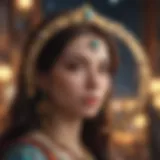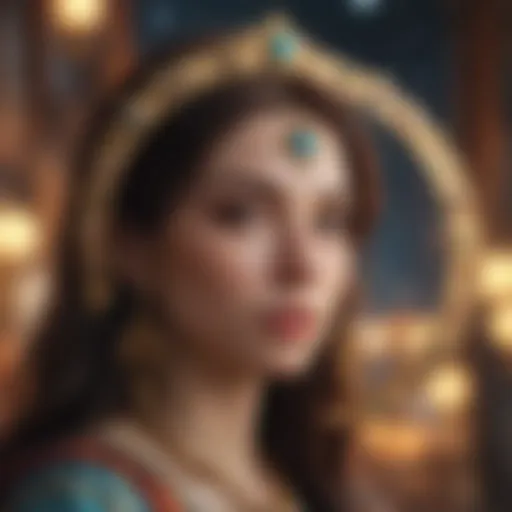Exploring the Rich Diversity of Tarot Cards
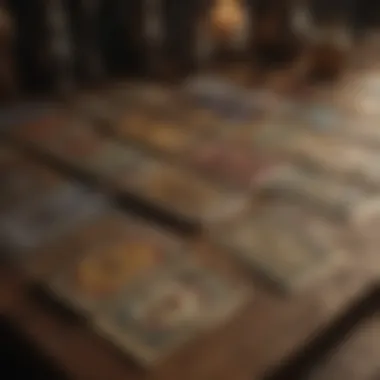

Intro
The world of tarot cards is as rich and layered as the fabric of the cosmos. Tarot has long fascinated people, offering a unique lens through which one can explore inner thoughts and feelings, as well as the dynamic flow of life itself. In this article, we will take a closer look at the various aspects of tarot cards, focusing on their diversity, symbolism, and relevance in today's spiritual practices.
From the intricate imagery that adorns each card to the interpretations that arise from different spreads, there’s so much ground to cover. Understanding how to navigate this cryptic world can significantly enhance one’s experience and mastery of tarot readings, whether you’re just dipping your toes in or are an experienced reader.
Let’s embark on this journey together, peeling back the layers of wisdom embedded in the tarot, and discover what makes each card a key to unlocking deeper knowledge about ourselves and the universe at large.
Characteristics of Tarot Cards
While not directly related to zodiac signs, understanding the characteristics of tarot cards themselves is fundamental to grasping their unique qualities. Each card, whether it belongs to the Major Arcana or Minor Arcana, possesses traits and associations that can contribute to a reading's depth and accuracy.
Overview of Major and Minor Arcana
The tarot deck is traditionally made up of 78 cards, divided into two main groups: the Major Arcana and the Minor Arcana. Each serves a distinct purpose in readings.
- Major Arcana: These cards symbolize significant life events, deeper spiritual lessons, and greater forces at play. Cards like The Fool, The Lovers, and Death tell stories that transcend day-to-day experiences.
- Minor Arcana: These cards delve into everyday circumstances, covering aspects of life that may feel mundane yet still hold great importance. They are divided into four suits: Cups (emotions), Pentacles (material aspects), Swords (intellect), and Wands (actions).
"The wisdom of tarot lies not just in the cards themselves but in the interpretations woven through experience and intuition."
Meaning of Key Cards
Each tarot card has its own nuanced meaning. Familiarity with these meanings allows readers to interpret readings more accurately.
- The Fool: Represents new beginnings and untapped potential. A clean slate.
- The Empress: Embodies fertility, beauty, and unconditional love.
- The Tower: Symbolizes sudden upheaval and the chaos that leads to rebirth.
Sample Interpretations in Different Spreads
Depending on the spread used, the same card can convey various insights:
- Three-Card Spread: Past, present, and future insights.
- Celtic Cross: A comprehensive overview of your current life situation.
Understanding how to place cards within different spreads can provide clarity and detail to readings, revealing more about the querent’s experiences and emotions.
Overview of Deck Styles
Tarot decks come in countless varieties, each with its own artistic flair and cultural resonance. A few notable styles include:
- Rider-Waite-Smith: The classic in tarot, known for its vivid imagery and symbolism.
- Thoth Tarot: Designed by Aleister Crowley, this deck dives deep into esotericism.
- Wild Unknown Tarot: Focuses on nature and the animal world, offering a modern approach.
Popular Decks and Their Unique Features
Some popular tarot decks stand out due to their unique features or thematic approach:
- Morgan-Greer Tarot: Known for its bold colors and titles in English.
- Deviant Moon Tarot: A deck steeped in surreal imagery.
- Everyday Witch Tarot: Blends magic with everyday life, approachable for all levels.
Each deck can provide different angles and insights, allowing readers to choose one that resonates personally. As we continue, we’ll examine how to interpret the cards more deeply and explore their role within various reading contexts.
Prelude to Tarot
To marvel at the richness and complexity of tarot cards is to step into a world painted with myriad meanings and possibilities. At their core, tarot cards serve not only as tools for divination, but also as gateways to deeper introspection. Understanding the essence of tarot is paramount for anyone venturing into this esoteric practice, be it an enthusiast, a seasoned reader, or a curious novice looking to explore the spiritual labyrinth of self-discovery.
The historical tapestry of tarot invites us to reflect on how these cards came to be and their transition from mere playing cards to revered instruments of insight. Knowing this foundation endows one with the knowledge needed to appreciate each card's significance and the impact it can have during readings.
Additionally, comprehending the purpose of tarot cards helps streamline the reading process. As individuals seek to navigate life’s uncertainties, tarot can serve as a potent emblem of guidance, bringing forth clarity amid chaos. This multifaceted utility underlies the persistent relevance of tarot across generations.
The benefits of becoming well-versed in tarot go beyond mere interpretation; it fosters a connection with intuition and personal agency. Clarity, understanding, and insight emerge as key components of the tarot experience, leading to personal empowerment.
"The cards are mirrors of our inner selves, reflecting what we often overlook."
When we peel back the layers and examine the purpose and history of tarot cards, we begin to see their vibrant potential, cultivatiing a fertile ground for future exploration.
The Structure of Tarot Decks
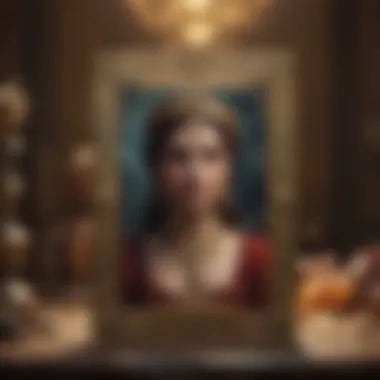

When diving into the tarot realm, understanding the structure of tarot decks is crucial. This framework not only shapes the way cards interact with one another but also influences their meanings and interpretations. The layout of a tarot deck, typically divided into two main components—the Major Arcana and the Minor Arcana—serves as a foundation, allowing practitioners to grasp the rich tapestry of symbolic language these cards convey.
In this section, we'll explore each of these components, highlighting their significance and the unique elements they bring to tarot readings.
Major Arcana
The Major Arcana is often perceived as the heart of a tarot deck. It comprises twenty-two cards, each laden with deep spiritual significance and representing profound life themes and lessons. Unlike the Minor Arcana, which reflects day-to-day experiences, the Major Arcana encapsulates the overarching journeys individuals encounter throughout their lives.
Significance of Major Arcana
The Significance of Major Arcana cannot be overstated. Each card in this series is a standalone narrative that often reflects pivotal moments or archetypes in human experience. For instance, cards like The Fool symbolize new beginnings, while The Lovers delve into themes of relationships and choices. This aspect of the Major Arcana allows readers to engage deeply with the cards, offering insights that can feel personal and immediate.
A key characteristic of the Major Arcana is that it addresses core dynamics of existence, providing rich layers of interpretation that resonate at various levels of consciousness. Unlike more routine card readings, drawing a Major Arcana card often indicates an impactful phase in one’s life, adding a weightiness that is reflective of its position.
The unique feature of the Major Arcana lies in its endurance and relevance across historical contexts, representing universal experiences that transcend cultural barriers. This makes it a popular choice for readers looking to uncover deeper narratives within their tarot practice. On the flip side, interpreting Major Arcana can sometimes elicit a sense of pressure or gravity, as these cards compel the reader to acknowledge significant themes rather than mundane facets of daily life.
Key Cards and Their Meanings
Delving further, the Key Cards and Their Meanings section within the Major Arcana captures the essence of individual cards. These key cards are not just placeholders but are imbued with potent symbology and metaphysical significance. Knowing each card can enhance a reader’s accuracy in conveying messages during readings.
For example, The High Priestess represents intuition and mystery, urging readers to trust their instincts. Another potent card, The Death, signifies transformation and endings, hinting at the metamorphoses that individuals undergo.
The invaluable trait of this subsection is clarity; the keywords and themes attached to each card can serve as anchors for both novice and advanced readers. However, a challenge arises due to the varied interpretations that exist based on cultural or personal perspectives—this can lead to confusion without a firm guide.
Minor Arcana
Moving to the Minor Arcana, we encounter a set of cards that provides a more intricate layer to readings. Comprising four suits—Cups, Pentacles, Swords, and Wands—these cards focus on the everyday aspects of life, such as emotions, finances, challenges, and actions.
Suits of the Minor Arcana
The Suits of the Minor Arcana each encapsulate distinct realms of experience. For example, the Cups relate to emotions and relationships, while Pentacles concentrate on material aspects like work and finance. This division allows readers to surface varied insights depending on the suit that dominates a reading.
A key characteristic is their focus on immediate scenarios; these cards often reflect current dynamics at play in a querent's life. Such specificity can be particularly beneficial, as it allows for practical advice and direction grounded in the present moment.
However, some might argue that the Minor Arcana lacks the gravitas of the Major Arcana. While this is a fair concern, it’s essential to recognize that understanding these cards enriches the overall narrative, providing necessary context and nuance to situations.
Court Cards Explained
The Court Cards within the Minor Arcana stand as a special case, portraying people, personality traits, and social influences. This aspect highlights the relationships and interactions that shape an individual's environment.
These cards—Pages, Knights, Queens, and Kings—are vital for providing insights into the querent’s personal sphere and external influences affecting their lives.
Key characteristics of Court Cards include their focus on interpersonal dynamics, making them invaluable in readings concerning relationships or community matters. Nonetheless, these cards can sometimes lead to ambiguity since the traits they embody may apply to various individuals in a querent’s life.
Their unique feature is rooted in their duality; the Court Cards can represent both aspects of the querent themselves and others affecting their journey. This flexibility can be beneficial but may also confuse readers about the right interpretation during readings.
By exploring both the Major and Minor Arcana, readers can better comprehend how different facets of life interconnect through the tarot, enriching their understanding and practice.
Different Types of Tarot Cards
When one delves into the world of tarot, the diversity of tarot cards stands out as a crucial theme. Each type of card brings its uniqueness to the reading process, influencing interpretations and outcomes. Understanding these different types helps practitioners tailor their approach to readings. The selections range from traditional decks that have remained largely unchanged over centuries to modern variations that reflect contemporary views. This section illuminates these distinct categories, giving context to their meanings and roles in tarot readings.
Traditional Tarot Cards
Traditional tarot cards are the bedrock of the practice. These decks, often rooted in European heritage, include well-known sets like the Rider-Waite and Marseille. The structure of traditional tarot is characterized by the classic categories of Major and Minor Arcana, each serving a vital role in readings.
Major Arcana are a series of 22 cards rich with significance, representing major life events or deep psychological themes. Cards like The Fool, The Magician, and Death illustrate key life stages and transformational experiences. This division allows readers to focus on broader life concepts.
Minor Arcana, on the other hand, comprises 56 cards that cover everyday experiences and situations. They further break into four suits: Cups, Pentacles, Swords, and Wands, each reflecting various aspects of life. This division helps in examining specific situations and directing attention where it’s needed most.
The historical context of these cards gives them a timeless quality, while their interpretations evolved with society's changing perspectives.
Modern Tarot Variations
With the rise of interest in tarot, modern variations emerged, each showcasing the flexibility of this ancient practice. These adaptations cater to diverse tastes and perspectives, rejuvenating tarot's appeal.
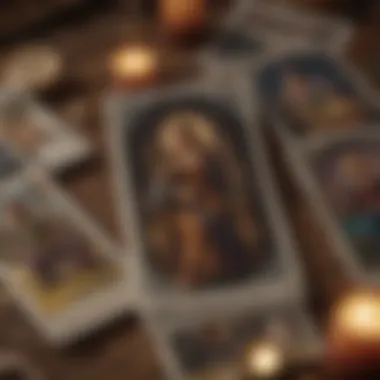

Artistic Interpretations
Artistic interpretations create a canvas where artistic vision meets spiritual insight. Artists infuse their personal style into the imagery, making each deck a unique piece of art. The shift from traditional art forms to contemporary visuals — like those seen in decks such as the Wild Unknown Tarot — has made these variations increasingly popular. Those who resonate more with modern aesthetics find these artistic interpretations appealing, often feeling a deeper connection with the visuals.
The primary characteristic of these decks is the imaginative imagery, which can evoke unique emotional responses during readings. However, the downside might be that the symbolism may stray from traditional meanings, creating confusion for some readers who rely on classical imagery for interpretations.
Cultural Influences
Cultural influences play a significant role in shaping modern tarot cards. Many decks incorporate elements from various traditions — whether it's Eastern philosophies, indigenous symbols, or pop culture references. This blend reflects a more inclusive understanding of spirituality. For example, the Afro-Brazilian inspired Tarot de Marseille resonates with users who appreciate its rich cultural narratives.
The essential attribute of these culturally influenced decks is their embrace of diversity. This adds layers of meaning that can resonate more personally with individuals from those backgrounds. However, one could argue that it might complicate traditional interpretations or lead to misunderstandings if one's not well-versed in the cultural contexts.
Oracle Cards vs. Tarot Cards
An important distinction often discussed alongside tarot is the difference between oracle cards and tarot cards. While both tools serve as conduits for guidance, they operate on different principles.
Defining Oracle Cards
Defining oracle cards often raises questions due to their varied nature. Unlike tarot decks with standardized structures, oracle cards can come in myriad forms and themes. They range from animal totem decks to affirmations, each card providing a unique message or insight, often more targeted than tarot cards. What makes oracle cards beneficial is their flexibility in themes, allowing users to select decks that resonate with their current life situations or emotions.
The uniqueness of oracle cards lies in their non-categorical nature, allowing for a more freestyle interaction compared to the more structured tarot, which could feel restrictive to some.
Similarities and Differences
Regarding similarities and differences, it's essential to understand that both oracle and tarot cards are designed to provide insight and guidance, but they convey this in different manners. While tarot cards rely heavily on established meanings and archetypes, oracle cards often reflect a more fluid set of messages. This key characteristic allows oracle cards to be a beneficial choice for those seeking a less rigid approach to spiritual guidance, effectively meeting individuals at their emotional and spiritual crossroads.
However, the lack of standardization in oracle decks could also be a drawback, as practitioners may find inconsistent interpretations across different oracle decks, which may confuse users accustomed to structured tarot meanings.
The Symbolism Behind Tarot Cards
In the realm of tarot, symbolism forms the backbone of interpretations, breathing life into each card’s imagery. The careful interplay of visual elements serves as a bridge between the tangible and the spiritual, helping readers connect the dots in their personal journeys. Not only do these symbols enrich the aesthetic quality of tarot, they also deepen the understanding of each card's message. This section will explore the common symbols that appear across various decks, their implications in readings, and the importance of interpretation in the context of tarot practice.
Common Symbols in Tarot
"Symbols are the language of the soul, speaking to our innate understanding of the universe."
Nature Imagery
Nature imagery in tarot cards offers a gateway to the natural world, linking human experiences to the cycles of life. Elements such as trees, water, mountains, and animals frequently surface in various decks, representing growth, strength, and the passage of time. This aspect of nature not only grounds readings in tangible realities but also evokes emotional responses, making the cards vivid to the querent.
A striking characteristic of nature imagery is its universality. Whether one finds solace in a serene lake or strength in a towering mountain, these symbols resonate deeply at a fundamental level. For example, the image of a blooming flower often signifies new beginnings or personal growth, creating an instant connection with the individual’s narrative.
However, while nature imagery is mostly perceived as beneficial, its interpretation can be nuanced. Some readers might struggle with interpreting certain symbols based on their personal experiences. For instance, a snake can symbolize transformation for one but invoke fear for another. This duality highlights the importance of understanding one’s own biases when interpreting these elements in a reading.
Numerical Significance
Numbers carry weight in tarot, serving as powerful carriers of meaning. Each number, imbued with its own attributes, contributes layers of interpretation, enriching the card's significance. The aces, for instance, often symbolize new beginnings due to their connection with the number one, while the tens can indicate completion or fulfillment, reflecting a journey's progress. This numerical significance aids in garnering insights beyond the surface meanings, providing a more robust framework for readings.
A crucial characteristic of numerical significance is its adherence to systems found in nature and life. For example, sequences and patterns often reveal underlying truths that guide the querent’s path. Such numerical interpretations rely on established traditions and are a widely accepted practice in tarot circles, ensuring consistency across diverse readings.
Nevertheless, an exclusive focus on numbers can sometimes lead to overlooking other symbolic aspects of the cards. For some, this may create an overly rigid framework that might hinder intuitive insights. Therefore, a balanced approach, integrating numerology with intuitive understanding, can enrich the experience and lead to more profound revelations.
Interpreting Symbols
Interpreting symbols in tarot is akin to deciphering a secret language—one that requires both intellect and instinct. Each card tells a story, shaped by its imagery, colors, and the context of a reading. To interpret effectively, one must cultivate an understanding not just of the cards, but also of their own inner voice.
A pivotal aspect of successful interpretation lies in the acknowledgment that symbols are not static; they can shift in meaning based on the context of a reading. This fluidity requires a reader to be adaptable, allowing intuition to guide while still adhering to traditional meanings.
In summary, the symbolism within tarot cards illuminates the journey of self-discovery and understanding. By exploring common symbols, such as nature imagery and numerical significance, and honing the art of interpretation, practitioners can navigate the intricate tapestry of tarot readings with greater clarity.
Tarot Card Spreads
In the realm of tarot, spreads are the backbone of any reading. They serve as the structured framework that guides the interpretation of the cards. Each spread is like a map, leading the querent through their concerns and illuminating paths previously obscured. A thoughtful selection of a tarot spread can enhance the effectiveness of a reading, providing insights that are nuanced and multidimensional. It shapes the inquiry and directs focus, ensuring clarity and depth in the messages conveyed by the cards.
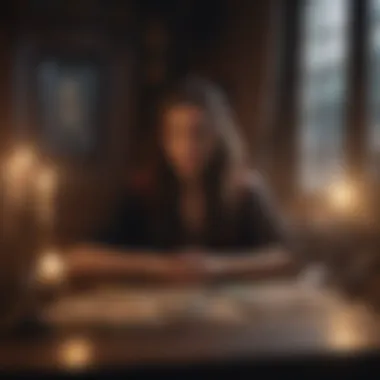

Popular Tarot Spreads
Three-Card Spread
The Three-Card Spread is among the simplest and yet profoundly insightful layouts one can use. Its beauty lies in its versatility, allowing it to tackle varied questions—be it past, present, future, or addressing any specific concern in a streamlined manner. The key characteristic that makes this spread so popular is its ability to deliver clear-cut guidance without overwhelming the reader with too many cards.
Think about it: just three cards mean less noise and more focus. Each card in this spread occupies a defined position, articulating a distinct aspect of the querent’s inquiry, thus offering a concise narrative. However, simplicity doesn't diminish its richness; rather, it can reveal so much by keeping it tight.
But this spread isn’t without its drawbacks. Its succinctness might not suffice for individuals seeking deeper exploration, as it limits the breadth of insights that a more extensive spread, such as the Celtic Cross, might provide. Still, for quick insights, the Three-Card Spread stands as a trustworthy ally in the tarot toolkit.
Celtic Cross Spread
Then there’s the Celtic Cross Spread, renowned for its depth and complexity. This spread is often seen as the gold standard for a full reading, as it provides an intricate picture of a situation and its context. It includes ten cards arranged in a cross pattern, with each position representing different dimensions of the question or situation.
What makes the Celtic Cross exceptionally valuable is its multi-layered approach. It can touch on past influences, current situations, and potential outcomes, weaving a rich tapestry of the querent's journey. The unique feature of this spread lies in its capacity to delve into various facets of life, allowing one to view their situation from multiple perspectives.
Yet, it can be a double-edged sword—while it’s detailed, the complexity might intimidate beginners or lead to information overload. Still, once mastered, the Celtic Cross can provide profound revelations and a holistic understanding of one’s circumstances.
Choosing a Spread
When selecting a spread, consider what questions or themes you want to explore. This is where the art of choosing a spread plays a pivotal role, almost like selecting a tool tailored perfectly for a project. Not all spreads fit every question, and honing in on one that aligns with the inquiry is crucial.
Considerations for Selection
Several factors should guide your selection. First, think about the nature of the question. Is it straightforward, or do you need guidance on a complex issue? The Three-Card Spread may suit quick answers, while the intricate needs of a life-altering decision might call for the Celtic Cross. Also, consider the experience level of the reader. Beginners might find it beneficial to start with simpler spreads before venturing into more elaborate ones. Each choice you make shapes the reading's effectiveness, providing clarity or creating confusion.
Tailoring Spreads for Specific Questions
Tailoring spreads for specific questions is another crucial aspect that enhances the reading's finesse. Modifying a traditional layout to better suit a particular concern can unleash deeper insights. For instance, if a querent is seeking clarity about a relationship, you might opt for a relationship spread or modify a common one to emphasize interpersonal dynamics.
This customizability is a standout feature of tarot. The ability to adapt provides a fresh layer to the experience, emphasizing areas of significance while still retaining the structure and foundation of conventional spreads. However, it’s essential to find a balance. Over-customizing can lead to diluted meanings or too much variation, thus losing the essence of the traditional layout.
“The right spread can act as a mirror, reflecting back what we need to see, helping us navigate the intricate tapestry of life.”
The Role of Intuition in Tarot
In the intricate tapestry of tarot reading, intuition acts as a vital thread weaving together the myriad elements of understanding and interpretation. It plays a fundamental role, guiding the reader's comprehension beyond mere card meanings. Intuition allows practitioners to connect with the nuanced energies surrounding a query, transforming a reading from a static analysis into a dynamic engagement with the subject at hand. The very nature of tarot relies not solely on memorized meanings but also on the ability to perceive and interpret those meanings in the context of individual circumstances. This shift from an analytical mindset to an intuitive approach can significantly deepen one’s insights and enrich the overall reading experience.
Listening to Inner Guidance
Listening to one's internal compass can be a game-changer for tarot readers. It's like standing at the edge of a cliff, feeling the wind shift just before the storm. Our instincts can often lead us to truths that are not immediately visible through the cards alone. For instance, while a particular card might signify turmoil, an intuitive flash might tell the reader that this pain could lead to a transformative experience. It’s essential to trust these gut feelings. They are often shaped by previous encounters and the reader's personal history.
Readers can enhance their ability to discern this inner voice through various practices. Meditation, for one, can clear the mental fog, making space for clarity. Journaling about past readings can also offer insights into patterns and recurring themes that may not be apparent at first glance. As one delves deeper into their own intuition, the messages derived from the tarot cards can morph from a general interpretation to a profound revelation that resonates with the individual's context.
Balancing Intuition and Structure
While intuition is a key player in tarot readings, a harmonious balance between instinct and the structure of card meanings is crucial. It's like cooking without a recipe; you might whip up something gut-warming, but without knowing the necessary ingredients, you could end up in unexpected culinary territory. Tarot cards come with a traditional framework that provides guidance and meaning. The Major Arcana and Minor Arcana each follow specific archetypes and elements that should not be forgotten.
Combining structure with intuition can lead to a fuller reading. During a session, if a reader feels an intuitive nudge, it’s worth examining how that aligns with the card’s established meaning. For example, the appearance of the Tower card, often associated with chaos, might evoke feelings of fear, but the reader’s intuitive sense could interpret it as a necessary breakdown for future growth. This synergy between the two elements enhances the reading, providing both depth and clarity.
"Intuition does not contradict the intellect; it works alongside it, illuminating paths unknown."
Closing Thoughts on Tarot Diversity
The journey through the abundant landscape of tarot cards provides not only insights into their intricate meanings but also reflects the richness of the human experience. In this exploration, we've seen how various types of tarot cards come together to unveil a multifaceted approach to understanding our inner selves and navigating the world around us. The diversity in tarot serves as a mirror, reflecting different cultural nuances, historical significance, and personal interpretations. As a result, the conversation surrounding tarot transcends mere card readings to become a dialogue about life's essence and purpose.
Influence of Tarot in Modern Culture
The use of tarot cards has proliferated in recent years, making a notable mark in popular culture. From television shows to social media platforms, tarot has found its way into the mainstream, attracting both seasoned enthusiasts and curious newcomers. Often depicted as a mystical art, tarot is no longer limited to esoteric circles; it has become a tool for self-reflection and personal growth for many.
Some interesting points to think about include:
- Diverse Representation: Different decks showcasing inclusivity are becoming increasingly popular.Additionally, artists are putting their unique spin on traditional designs, making tarot more accessible and relatable.
- Mindfulness and Well-Being: Many see tarot as a form of mindfulness, encouraging individuals to slow down and reflect on their feelings and thoughts.
- Community and Connection: Online platforms such as Reddit and Facebook groups provide spaces for individuals to share their experiences, deepen their understanding, and build networks around tarot.
This mixture of visibility and community engagement has solidified tarot cards as modern artifacts capable of fostering connection rather than division.
"Tarot is a tool that helps people navigate their emotions and experiences, acting as a bridge between the tangible and the spiritual."
Encouraging Personal Exploration
As tarot enthusiasts venture through this bustling world, personal exploration becomes paramount. Rather than solely relying on established meanings, individuals should feel encouraged to discover their own interpretations. This approach fosters a deeper, more personal relationship with the cards. Here’s how one might approach their own journey:
- Journaling: Maintain a tarot journal to record readings, feelings, and evolving interpretations over time. This practice can unveil patterns and insights unique to one's journey.
- Experimenting with Decks: Try various decks and styles, as each deck carries a distinct energy and aesthetic. This variety can lead to unexpected revelations.
- Listening to Intuition: Trust your instincts and allow space for the intuitive messages that arise during readings. This guidance may sometimes diverge from traditional meanings, offering new perspectives.
